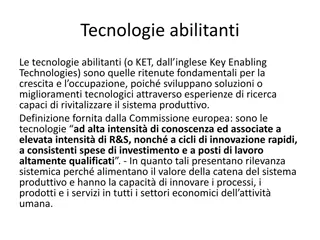
Biotechnology and Industrial Microbiology in Practice
Explore the nature of biotechnology and industrial microbiology, from the definition set at the Rio de Janeiro conference in 1992 to the production of fungal primary and secondary metabolites. Learn about fermentation, the use of organic acids, vitamins, and more in industrial applications.
Download Presentation

Please find below an Image/Link to download the presentation.
The content on the website is provided AS IS for your information and personal use only. It may not be sold, licensed, or shared on other websites without obtaining consent from the author. If you encounter any issues during the download, it is possible that the publisher has removed the file from their server.
You are allowed to download the files provided on this website for personal or commercial use, subject to the condition that they are used lawfully. All files are the property of their respective owners.
The content on the website is provided AS IS for your information and personal use only. It may not be sold, licensed, or shared on other websites without obtaining consent from the author.
E N D
Presentation Transcript
NATURE OF BIOTECHNOLOGY AND INDUSTRIAL MICROBIOLOGY Rio de Janeiro, Brazil in 1992: That conference defined biotechnology as any technological application that uses biological systems, living organisms, or derivatives thereof, to make or modify products or processes for specific use.
THE USE OF THE WORD FERMENTATION IN INDUSTRIAL MICROBIOLOGY The word fermentation comes from the Latin verb fevere, which means to boil.
The mold Penicillium notatum growing in a flask of culture medium for the production of penicillin in the early days of the antibiotic age. (From Ref. 166.)
PRODUCTION OF FUNGAL PRIMARY METABOLITES 1. Alcohols: Ethyl alcohol is a primary metabolite that can be produced by fermentation of a sugar, or a polysaccharide that can be depolymerized to a fermentable sugar. Yeasts are preferred. 2. Organic Acids, e.g. Citric acid is easily assimilated, is palatable, and has low toxicity. Consequently, it is widely used in the food and pharmaceutical industry. It is employed as an acidifying and flavor-enhancing agent, an antioxidant for inhibiting rancidity in fats and oils, a buffer in jams and jellies, and a stabilizer in a variety of foods. The pharmaceutical industry uses approximately 16% of the available supply of citric acid.
Other valuable organic acids include acetic, lactic, malic, gluconic, fumaric, itaconic, tartaric, pyruvic, and succinic acids. 3. Vitamins, e.g: Riboflavin (vitamin B2) 4. Other Applications: Some microbial strains produce very high concentrations of extracellular enzymes (e.g., strains of Aspergillus produce 20 g/L of glucoamy- lase [28]).
FUNGAL SECONDARY METABOLITES secondary metabolites are usually produced after growth has slowed down. They have no function in growth of the producing cultures, are produced by certain restricted taxonomic groups of organisms, and are usually formed as mixtures of closely related members of a chemical family. In nature, secondary metabolites are important for the organisms that produce them, functioning as (1) sex hormones; (2) ionophores; (3) competitive weapons against other bacteria, fungi, amoebae, insects and plants; (4) agents of symbiosis; and (5) effectors of differentiation [34]. A great many of these secondary metabolites are produced by fungi.
1. Antibiotics Antibiotics are defined as low-molecular- weight organic natural products made by micro-organisms that are active at low concentration against other microorganisms. 2. Pharmacological Agents 3. Pigments
REGULATION OF FUNGAL SECONDARY METABOLISM 1. Regulation by the Carbon Source 2. Regulation by the Nitrogen Source 3. Regulation by the Phosphorus Source 4. Regulation by Metals
Induction of Secondary Metabolite Synthases
SOME RAW MATERIALS USED IN COMPOUNDING INDUSTRIAL MEDIA cheapness, ready availability, constancy of chemical quality, etc. (a)Corn steep liquor:This is a by-product of starch manufacture from maize. (b) Pharmamedia: Also known as proflo, this is a yellow fine powder made from cotton-seed embryo.
(c) Distillers solubles: This is a by-product of the distillation of alcohol from fermented grain. (d) Soya bean meal: Soya beans (soja) (Glycine max), is an annual legume which is widely cultivated throughout the world in tropical, sub-tropical and temperate regions between 50 N and 40 S. The seeds are heated before being extracted for oil that is used for food, as an anti- foam in industrial fermentations, or used for the manufacture of margarine. The resulting dried material, soya bean meal, has about 11% nitrogen, and 30% carbohydrate and may be used as animal feed. Its nitrogen is more complex than that found in corn steep liquor and is not readily available to most microorganisms, except actinomycetes. It is used particularly in tetracycline and streptomycin fermentations.
(e) Molasses: It is a by-product of the sugar industry. There are two types of molasses depending on whether the sugar is produced from the tropical crop, sugar cane (Saccharum officinarum) or the temperate crop, beet, (Beta alba). (f) Sulfite liquor: Sulfite liquor (also called waste sulfite liquor, sulfite waste liquor or spent sulfite liquor) is the aqueous effluent resulting from the sulfite process for manufacturing cellulose or pulp from wood. Depending on the type, most woods contain about 50% cellulose, about 25% lignins and about 25% of hemicelluloses.
DEFINITION OF A FERMENTOR A fermentor (or fermenter) is a vessel for the growth of microorganisms which, while not permitting contamination, enables the provision of conditions necessary for the maximal production of the desired products. In other words, the fermentor ideally should make it possible to provide the organism growing within it with optimal pH, temperature, oxygen, and other environmental conditions. In the chemical industry, vessels in which reactions take place are called reactors. Fermentors are therefore also known as bioreactors. Fermentors may be liquid, also known as submerged or solid state, also known as surface. Most fermentors used in industry are of the submerged type, because the submerged fermentor saves space and is more amenable to engineering control and design.
BARLEY BEERS The word beer derives from the Latin word bibere meaning to drink. The process of producing beer is known as brewing. Beer brewing from barley was practiced by the ancient Egyptians as far back as 4,000 years ago, but investigations suggest Egyptians learnt the art from the peoples of the Tigris and Euphrates where man s civilization is said to have originated. The use of hops is however much more recent and can be traced back to a few hundred years ago.






















